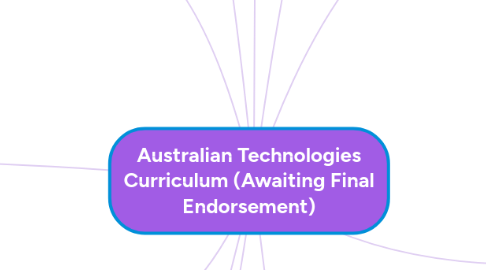
1. Band Levels
1.1. Foundation - Year 2
1.2. Years 3 and 4
1.3. Years 5 and 6
1.4. Years 7 and 8
1.5. Years 9 and 10
2. Strands, Subjects and Structure
2.1. Knowledge and Understanding
2.1.1. Design and Technology
2.1.1.1. • the use, development and impact of technologies in people’s lives. • design concepts across a range of technologies contexts.
2.1.2. Digital Technology
2.1.2.1. • how data are represented and structured symbolically. • the components of digital systems: software, hardware and networks. • the use, development and impact of information systems in people’s lives.
2.2. Processes and Production Skills
2.2.1. Design and Technology
2.2.1.1. • critiquing, exploring and investigating needs or opportunities. • generating, developing and evaluating design ideas for designed solutions. • planning, producing and evaluating designed solutions.
2.2.2. Digital Technology
2.2.2.1. • collecting, managing and interpreting data when creating information, and the nature and properties of data, how it is collected and interpreted. • using a range of digital systems and their components and peripherals. • defining problems and specifying and implementing their solutions. • creating and communicating information, especially online, and interacting safely using appropriate technical and social protocols.
3. Student Diversity
3.1. Gifted and Talented Students
3.2. Students with disabilities
3.3. English as an Additional Language or Dialect Students
4. Cross-curriculum Priorities
4.1. Aboriginal and Torres Strait Islander histories and cultures.
4.2. Asia and Australia’s engagement with Asia.
4.3. Sustainability.
5. Content Descriptions
5.1. The Australian Curriculum: Technologies includes content descriptions at each band level. These describe the knowledge, understanding and skills that teachers are expected to teach and students are expected to learn.
5.2. Content descriptions do not prescribe approaches to teaching in the Technologies subjects. The content descriptions have been written to ensure that learning is ordered appropriately and that unnecessary repetition is avoided.
5.3. Content descriptions are grouped to illustrate the clarity and sequence of development of concepts through and across the band levels. They support the ability to see the connections across strands and the sequential development of concepts from Foundation to Year 10.
6. Content Elaborations
6.1. Content elaborations are provided for Foundation to Year 10 as support material to illustrate and exemplify what is to be taught and to assist teachers in developing a shared understanding of the content descriptions.
6.2. They are not intended to be comprehensive content points that all students need to be taught nor do they encompass every aspect of a content description.
7. Aims and Objectives
7.1. Students are creative, innovative and enterprising when using traditional, contemporary and emerging technologies, and understand how technologies have developed over time.
7.2. Students effectively and responsibly select and manipulate appropriate technologies, resources, materials, data, systems, tools and equipment when designing and creating products, services, environments and digital solutions.
7.3. Students critique and evaluate technologies processes to identify and create solutions to a range of problems or opportunities.
7.4. Students investigate, design, plan, manage, create, produce and evaluate technologies solutions.
7.5. Students engage confidently with technologies and make informed, ethical and sustainable decisions about technologies for preferred futures including personal health and wellbeing, recreation, everyday life, the world of work and enterprise, and the environment.
8. Key Concepts
8.1. Abstraction
8.2. Data collection, representation and interpretation.
8.3. Digital Systems
8.4. Interactions and impacts
8.5. Specification, algorithms and implementation.
9. Key Ideas
9.1. Systems Thinking
9.1.1. Systems Thinking Focus: using knowledge, understanding & skills to break down and learn about systems & their components.
9.1.2. Sustainability (cross curriculum priority).
9.1.3. Opportunities for students to predict outcomes and be creative.
9.2. Project Management
9.2.1. Managing projects using the required skills.
9.3. Creating Preferred Futures
9.3.1. Overarching idea. Systems approach: Holistic approach to identifying and moving towards ethical, socially responsible and sustainable patterns of living.
9.4. Thinking in Technologies
9.4.1. Systems Thinking
9.4.2. Design Thinking
9.4.3. Creative and Critical Thinking
9.4.4. Computational Thinking
10. General Capabilities
10.1. Literacy (LIT)
10.2. Numeracy (NUM)
10.3. Information and communication technology capability (ITC)
10.4. Critical and creative thinking (CCT)
10.5. Personal and social capability (PSC)
10.6. Ethical Understanding (EU)
10.7. Intercultural Understanding (ICU)
11. Achievement Standards
11.1. The sequence of achievement standards in each Technologies subject describes progress in the learning area, demonstrating a broad sequence of expected learning. This sequence provides teachers with a framework of growth and development in each Technologies subject.
11.2. The achievement standards for Technologies reflect the distinctive practices of each subject along with aspects of learning that are common to all Technologies subjects.
11.3. Achievement standards will be accompanied by portfolios of annotated student work samples that illustrate the expected learning and help teachers to make judgments about whether students have achieved the standard.
11.3.1. Across Foundation to Year 10, achievement standards indicate the quality of learning that students should typically demonstrate by a particular point in their schooling.
